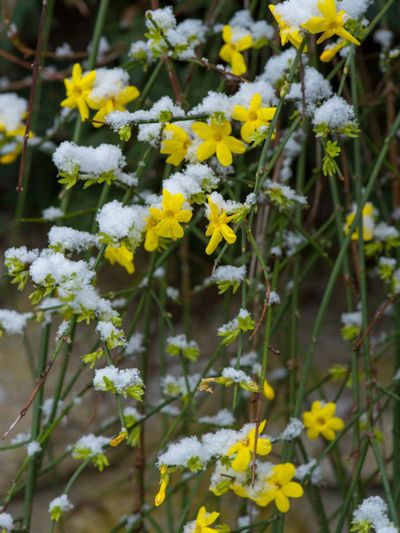There are over 200 species of jasmine. Here are some of the types commonly grown in the United States and USDA plant hardiness zones:
Winter jasmine (J. nudiflorum): Zones 6 through 9, may even bloom during winter Arabian jasmine (J. sambac): Zones 9 through 11 Common jasmine (J. officinale): Zones 7 through 10 Star/Confederate jasmines (Trachelospermum spp.): Zones 8 through 10
How to Keep Jasmine Over Winter
If you are growing the plants in their rated zone, you need to provide a layer of organic mulch to the roots of the jasmine in winter. Use up to 6 inches (15 cm.) of straw or 3 to 4 inches (8-10 cm.) of shredded hardwood for winterizing jasmine plants. Fallen leaves also make good winter mulch, and they work even better if you shred them to about the size of a quarter before spreading them over the roots. If the stems begin to die back, you can cut them down as low as 6 inches (15 cm.) above the ground. To keep jasmine plants over winter outside their rated zone, you need to bring them indoors. Growing them in pots makes moving the plants indoors for winter much easier. Even so, dry indoor air and inadequate sunlight may cause the plants to lose their leaves and they may even die. While they are indoors, give the plants normal room temperatures during the day with cool temperatures at night. This allows them to rest over winter. Prepare the plants by bringing them in for a few hours each day several weeks before the first frost. When you bring them in, place them in a very bright, preferably south-facing window. Use supplemental fluorescent lighting if you don’t have enough natural light in your home. The bathroom, kitchen, and laundry room are the most humid rooms in your house, and they make good winter homes for jasmine plants. If you run your furnace a lot over winter, the air will be dry. You can provide the plant with a little extra humidity by placing it on a tray of pebbles and water. The purpose of the pebbles is to hold the pot above the water. As the water evaporates, it moistens the air around the plant. A cool mist vaporizer will also help keep the air moist. It’s safe to move the plant back outdoors after the danger of frost has passed. Feed it with liquid fertilizer and give it a few days to get used to outdoor conditions before leaving it outside overnight.
